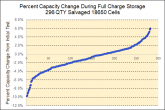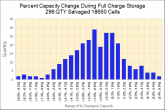Stevo57
New Member
- Joined
- Sep 26, 2019
- Messages
- 9
Being new to this, I made the mistake of storing fully charged 18650 cells that I've salvaged from used laptop batteries. Here are the results from the before and after for 316 cells that I had tested using a Litokala Engineer 500, then stored for between 6 mo and 9 mo, at a full state of charge (4.2v nominal).
I totally get that the Litokala tester is not laboratory grade, and that you can run five tests and get five different answers, but it's what I have and I think the results speak for themselves. The majority of the salvaged cells lost some capacity. About 5% lost over 25% capacity. A few were "heaters" to the point I pulled them and called them 100% loss. One cell ended up at 0v, so was a complete loss. Some cells actually showed an increase in capacity on the second test.
I haven't seen anybody produce any real data on this, and while not "scientific grade" data, it's worth showing. First chart is the total population of the test. The second chart is with anything greater than 10% loss pulled from the population. The histogram shows the bucket. The median change in capacity was -0.7%. The Average change in capacity was -0.6%.
So, don't store your 18650's at full SOC!



I've built a few batteries now that work great, and am setting up a solar system. Will show that later. Right now, just enjoying how well they work on my ebike.
My process now is: Salvage cells, keeping the good ones. I do charge up the cells with more than 1.0v, even though folks say these are "iffy". That's probably true.
I test them twice, then store for around four weeks at full charge. Any that drop by more than 0.1v get pulled as "self-dischargers". Then I discharge the remaining cells to about 3.65v using a resistor bank. These are the cells that go into storage until I need them.
When ready to use, I check for self-dischargers again, and those get pulled and sent to recycle.
So, let the trolling begin from all the anti-18650 folks out there. I'm having a lot of fun with these.
Also building a 160AH LiFePo 24V set-up for my camper. I'm using prismatics and its very similar to the one Will has made a video about.
Enjoy, and happy to answer any questions about 18650 usage. I've learned a lot over the past year.
Cheers
I totally get that the Litokala tester is not laboratory grade, and that you can run five tests and get five different answers, but it's what I have and I think the results speak for themselves. The majority of the salvaged cells lost some capacity. About 5% lost over 25% capacity. A few were "heaters" to the point I pulled them and called them 100% loss. One cell ended up at 0v, so was a complete loss. Some cells actually showed an increase in capacity on the second test.
I haven't seen anybody produce any real data on this, and while not "scientific grade" data, it's worth showing. First chart is the total population of the test. The second chart is with anything greater than 10% loss pulled from the population. The histogram shows the bucket. The median change in capacity was -0.7%. The Average change in capacity was -0.6%.
So, don't store your 18650's at full SOC!



I've built a few batteries now that work great, and am setting up a solar system. Will show that later. Right now, just enjoying how well they work on my ebike.
My process now is: Salvage cells, keeping the good ones. I do charge up the cells with more than 1.0v, even though folks say these are "iffy". That's probably true.
I test them twice, then store for around four weeks at full charge. Any that drop by more than 0.1v get pulled as "self-dischargers". Then I discharge the remaining cells to about 3.65v using a resistor bank. These are the cells that go into storage until I need them.
When ready to use, I check for self-dischargers again, and those get pulled and sent to recycle.
So, let the trolling begin from all the anti-18650 folks out there. I'm having a lot of fun with these.
Also building a 160AH LiFePo 24V set-up for my camper. I'm using prismatics and its very similar to the one Will has made a video about.
Enjoy, and happy to answer any questions about 18650 usage. I've learned a lot over the past year.
Cheers


